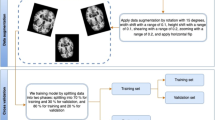Abstract
Purpose
Computer-aided MRI analysis is helpful for early detection of Alzheimer’s disease(AD). Recently, 3D convolutional neural networks(CNN) are widely used to analyse MRI images. However, 3D CNN requires huge memory cost. In this paper, we introduce cascaded CNN and long and short-term memory (LSTM) networks. We also use knowledge distillation to improve the accuracy of the model using small medical image dataset.
Methods
We propose a cascade structure, CNN-LSTM. CNN is used as the function of feature extraction, and LSTM is used as the classifier. In this way, the correlation between different slices can be considered and the calculation cost caused by 3D data can be reduced. To overcome the problem of limited image training data, transfer learning is a more reasonable way of feature extraction. We use the knowledge distillation algorithm to improve the performance of student models for AD diagnosis through a powerful teacher model to guide the work of student models.
Results
The accuracy of the proposed model is improved using knowledge distillation. The results show that the accuracy of the student models reached 85.96% after the guidance of the teacher models, an increase by 3.83%.
Conclusion
We propose cascaded CNN-LSTM to classify 3D ADNI data, and use knowledge distillation to improve the model accuracy when trained with small size dataset. It can process 3D data efficiently as well as reduce the computational cost.











Similar content being viewed by others
References
Patterson C(2018) The state of the art of dementia research: new frontiers. World Alzheimer Report
Wasule V, Sonar P (2017) Classification of brain mri using svm and knn classifier. In: 2017 Third International Conference on Sensing, Signal Processing and Security (ICSSS), pp. 218–223 . IEEE
Moore P, Lyons T, Gallacher J (2019) Random forest prediction of Alzheimer’s disease using pairwise selection from time series data. PLOS One 14(2):1–14
Subramoniam M, Aparna T, Anurenjan P, Sreeni K (2022)Deep learning-based prediction of alzheimer’s disease from magnetic resonance images, 145–151
Nawaz A, Anwar S.M, Liaqat R, Iqbal J, Bagci U, Majid M Deep convolutional neural network based classification of alzheimer’s disease using mri data. In: 2020 IEEE 23rd International Multitopic Conference (INMIC), 1–6 (2020). IEEE
Xing X, Liang G, Blanton H, Rafique M.U, Wang C, Lin A.-L, Jacobs N (2020) Dynamic image for 3d mri image alzheimer’s disease classification. In: European Conference on Computer Vision, pp. 355–364. Springer
Hon M, Khan NM (2017) Towards alzheimer’s disease classification through transfer learning. In: 2017 IEEE International Conference on Bioinformatics and Biomedicine (BIBM), pp. 1166–1169. IEEE
Hao R, Namdar K, Liu L, Khalvati F (2021) A transfer learning-based active learning framework for brain tumor classification. Front Artif Intell 4:635766
Korolev S, Safiullin A, Belyaev M, Dodonova Y Residual and plain convolutional neural networks for 3d brain mri classification. In: 2017 IEEE 14th International Symposium on Biomedical Imaging (ISBI 2017), pp. 835–838 (2017). IEEE
Khvostikov A, Aderghal K, Benois-Pineau J, Krylov A, Catheline G 3d cnn-based classification using smri and md-dti images for alzheimer disease studies. 2018. In: Computer Vision and Pattern Recognition
Huang Y, Xu J, Zhou Y, Tong T, Zhuang X (2019) Diagnosis of alzheimer’s disease via multi-modality 3d convolutional neural network. Front Neurosci 13:509–509
Yosinski J, Clune J, Bengio Y, Lipson H How transferable are features in deep neural networks? Advances in neural information processing systems (NIPS) (2014)
Pan SJ, Yang Q (2009) A survey on transfer learning. IEEE Tran Knowl Data Eng 22(10):1345–1359
Huang G, Liu Z, Van Der Maaten L, Weinberger K.Q Densely connected convolutional networks. In: Proceedings of the IEEE Conference on Computer Vision and Pattern Recognition, pp. 4700–4708 (2017)
He K, Zhang X, Ren S, Sun J (2016) Deep residual learning for image recognition. In: Proceedings of the IEEE Conference on Computer Vision and Pattern Recognition, 770–778
Fung Y.R, Guan Z, Kumar R, Wu J.Y, Fiterau M Alzheimer’s disease brain mri classification: Challenges and insights. http://arxiv.org/abs/1906.04231 (2019)
Author information
Authors and Affiliations
Corresponding author
Ethics declarations
Conflict of interest
The authors declare that they have no conflict of interest.
Ethical approval
This article does not contain any studies with human participants or animals performed by any of the authors.
Informed consent
Informed consent was obtained from all individual participants included in the study.
Additional information
Publisher's Note
Springer Nature remains neutral with regard to jurisdictional claims in published maps and institutional affiliations.
Rights and permissions
About this article
Cite this article
Li, Y., Luo, J. & Zhang, J. Classification of Alzheimer’s disease in MRI images using knowledge distillation framework: an investigation. Int J CARS 17, 1235–1243 (2022). https://doi.org/10.1007/s11548-022-02661-9
Received:
Accepted:
Published:
Issue Date:
DOI: https://doi.org/10.1007/s11548-022-02661-9




